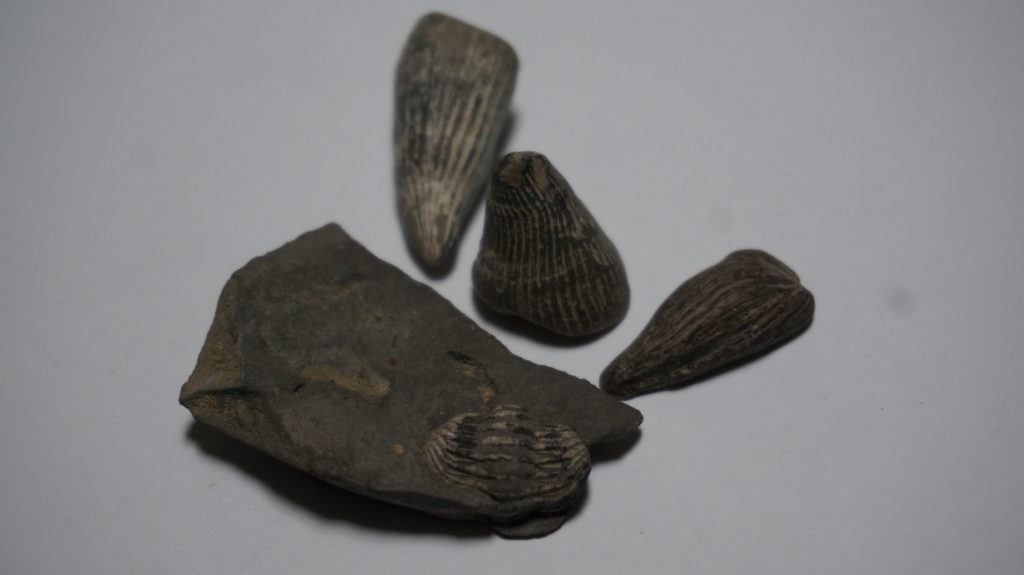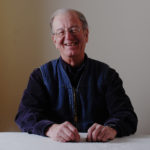Fossil hunting sparks imaginations
by Stephen Lewandowski –
Fossil – from the Latin fossilis, something dug up ~ Preserved remains or record of the presence of plants or animals
 First impressions can be deceptive. Most of us came to fossils through our interest in dinosaurs and the lush land life of the Jurassic Period. We expect our fossils to be big, dramatic, preferably carnivorous animals. Who wasn’t tremendously excited to see the battle between Triceratops and Tyrannosaurus Rex in Fantasia? So that’s what we thought fossils were all about. We were disappointed to learn that our local fossils weren’t huge dinosaurs. The Jurassic was relatively recent and short-lived compared to the fossil record of our area. Fossils of this region tend to be small life forms, such as sponges, corals and bivalves. One rarely runs across a predator. It’s hard not to be disenchanted at first.
First impressions can be deceptive. Most of us came to fossils through our interest in dinosaurs and the lush land life of the Jurassic Period. We expect our fossils to be big, dramatic, preferably carnivorous animals. Who wasn’t tremendously excited to see the battle between Triceratops and Tyrannosaurus Rex in Fantasia? So that’s what we thought fossils were all about. We were disappointed to learn that our local fossils weren’t huge dinosaurs. The Jurassic was relatively recent and short-lived compared to the fossil record of our area. Fossils of this region tend to be small life forms, such as sponges, corals and bivalves. One rarely runs across a predator. It’s hard not to be disenchanted at first.
It so happens that the part of the Devonian Period into which first glaciers then streams and rivers have carved an entry was extremely rich in life from which fossils could be made. Three hundred and sixty million years ago, this area was underwater and going through a sedimentary process in which hard-bodied life forms were buried in the sediments settling out of the water. First, stone formed a cast around their shape, then their shape was replaced by stone.
Fossil hunting requires exposed bedrock, and bedrock is exposed, even fractured and grooved, where glaciers have been at work. In western New York the glaciers only went out of business about thirteen thousand years ago, so the bedrock they bared is still relatively fresh. Over the past two hundred years, however, the open shale, siltstone, and limestone cliffs and mineshave been quite thoroughly investigated, first by geologists, then by collectors, and finally by residents, especially children. Teaching western New York State children to look for fossils fulfills an important function in cultural as well as natural heritage.
Learning about fossils enables children to develop the reasoning ability they will need to participate in the scientific method of discovery. The disciplines of Taxonomy, Geology, Paleontology, Zoology, Botany, and Evolutionary Biology, among others, are strongly dependent on understanding the fossil record. Teaching children about fossils will not make scientists of them, but it keeps that option open.
Waiting for a friend with business in the town bank, I window shop for clothes, fishing tackle, and toys in the evening along Main Street. The winter darkness has fallen quickly and completely as the display windows are lit. I have some company at the toy store: a well-dressed man stares at the dinosaur display of posters, plastic models, balsa replicas, and blow-ups of the great reptiles.
Lit by recessed spotlights, the bulky Brachiosaurs and Diplodocus browse green Astroturf and flee from Coelurus and Tyrannosaurus while the Pterosaurs float above. Labyrinthodonts bask in the ferns beside blue mirror pools on which Plesiosaurs and Icthyosaurs are poised.
Look, there’s a flock of young Ankylosaurs. You can tell they’re young because their spines haven’t grown in yet. They better be careful, and where do you suppose their momma’s at? When I was young and the language was growing in me, it developed frills, lobes, crests and bills like these.
I am wondering if this man shares my memories of a childhood lost in books, handling fossils, considering blood-splashed illustrations and fascinated by the ancient world of cold-blooded reptile flesh and teeth tearing at one another when under his breath I hear him say “Oh, wow!”
Fossils spark imaginations. We say, “What I hold in my hand was once alive and lived its life right here.” Hunting for fossils engages an instinctual recognition of patterns, and we often respond to these patterns emotionally. The thrill of finding a fossil stems not only from the sense of discovery since “It was right there all along and I found it,” but from a sense of identification, prompting us to ask, “I wonder what its life was like?”
For years, the Devonian period appeared to me in stone colors, shades of grey, silver, white, brown and black, the predominant colors of the local fossil record. This is probably wrong. How would we know what the actual colors were so many million years ago? Pigments rarely fossilize. But there certainly would have been a great deal of green in the plant life, and the most likely modern analog to the shallow, salty Devonian seas are the ocean reefs near modern islands and shores. They are full of color! Imagine the drab grey and brown fossils we dig out of the shale in their original hues, violent purples and extravagant oranges.
There are a number of activities, fossil-hunting among them, which seem to engage a different set of our senses than everyday life does. I suspect that hunting anything engages these senses in recognition of specific patterns. It may be that these innate abilities are as ancient as the human hunter-gatherer roles.
I had the experience recently of happening on a pile of fractured limestone left over from a construction project and dumped in a field. At first glance, there didn’t seem to be anything unusual about it. As I looked more closely at the stone to try to identify the source, at first I couldn’t, but then I saw a horn coral fossil protruding from one corner. No sooner had one fossil appeared than, scanning the pile, hundreds of fossils of all kinds emerged. It was the same stone in the same place in the same light, but suddenly my eyes became attuned to the fossil designs. It was almost like looking into the stone.
I’ve had similar encounters with mushrooms: out in the woods in the fall after a rain, leaves crunching underfoot, looking for mushrooms but really not much going on. Nothing… nothing, until we saw the first, and then as if by magic there seemed to be mushrooms all around. Recognizing the color and pattern of the first mushroom suddenly reveals a whole field of mushrooms. I hunkered down in them.
Whether the quarry is fossils or mushrooms, berries or animals, there’s a consistent pattern of being frustrated at first, then clued in, and finally overwhelmed. Native American herbalists often speak of a similar experience when they describe taking a properly respectful approach to gathering medicinal plants. They say the plants reveal themselves at the right time and when the conditions are right to people who are in the proper frame of mind. If any of these factors are off, the plants will remain “invisible” no matter how thorough the search.
There’s always the matter of not finding fossils. Will your day be ruined if you find no fossils? Not likely, because there are many worse ways to spend a few hours than in a deep, shady glen with a small stream and perhaps some waterfalls, ferns and mosses. The dappled light streams through green birch boughs. Pick a hot day, because the glen will always be ten degrees cooler and breathing out cool, hemlock-scented air.
The Museum of the Earth (an educational arm of the Paleontological Research Institution in Trumansburg, NY) offers an opportunity to explore fossils and more. The museum’s web site –www.priweb.org/index.php/museumoftheearth-main – invites visitors to: “Explore Earth and its prehistoric past—from the tiniest trilobite to the mighty mastodon—through engaging displays, hands-on features, stunning fossils, and science-inspired art.” They host fossil identification days on the Second Saturday of each month from 10am – Noon (Included with Museum admission), have a fossil lab where kids can search for and take home fossils and host several summer fossil digs. The next and final dig will take place on August 11th, 2018 near Schoharie, NY. There are only a few slots left. Collecting at each site begins at 11 am and ends at 2 pm. For more information about the trips, and to register, please contact Rob Ross at 607-273-6623 x18 or via email at ross@priweb.org.

Stephen Lewandowski was born in Canandaigua, NY in 1947. When his ethnobotanist parents were killed in a plane crash, he survived and was reared by bears in the Southern Tier of New York. Later, he was discovered, shaved and clothed, and sent to Hamilton College where he studied English Literature. Not completely civilized by this experience, he also did graduate work in philosophy and folklore. He enjoys being outdoors and, being recently retired from gainful employment with the Soil Conservation, hopes to range freely again. Writing, even thinking, is painful to him.